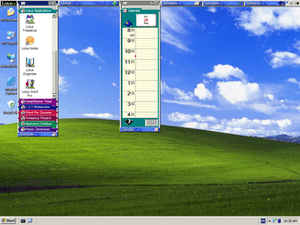IBM Lotus SmartSuite
|
| |
|
Lotus SmartCenter icon and screenshot of the Lotus SmartCenter toolbar | |
| Developer(s) | IBM |
|---|---|
| Initial release | 1992 |
| Stable release |
9.8.6
/ 2008 |
| Operating system | Microsoft Windows, OS/2 |
| Type | Office suite |
| License | Proprietary |
| Website |
www |
SmartSuite is an office suite from Lotus Software. The company made versions of its office suite for IBM OS/2 and Microsoft Windows.
Status
SmartSuite is in maintenance mode, and supported with fixes and fixpacks on Windows 2000 and Windows XP. SmartSuite is not officially supported by IBM on versions of Windows after XP, but it does work well on both the 32-bit and 64-bit versions of Vista and of Windows 7, if the installer and applications are run with XP compatibility mode set for the executable files. IBM has no plans to release an official Windows 7-compatible version of SmartSuite.[1]
In 2007, IBM introduced a new office suite called IBM Lotus Symphony, unrelated to the Lotus Symphony integrated application suite that Lotus previously released.
In July 2012 the price for a user licence of Lotus SmartSuite 9.8 was US-$342.00 when purchased directly through the IBM website.[2]
In May 2013, IBM announced the withdrawal of SmartSuite. Marketing of the product ended in June 2013, followed by all support ceasing in September 2014. IBM has also announced that there will be no replacement for SmartSuite.[3]
Components
The following applications are included in SmartSuite for Microsoft Windows:
- Lotus Word Pro — word processor; previously called Ami Pro; .lwp files
- Lotus 1-2-3 — spreadsheet; .123, .wk1, .wk3, .wk4 files
- Lotus Freelance Graphics — presentation software; .prz files
- Lotus Approach — relational database; .apr (data entry and reports), .dbf (database) files
- Lotus Organizer — personal information manager; .org, .or2, .or3 files
- Lotus SmartCenter — a toolbar that let users quickly access programs, calendar, Internet bookmarks, and other resources
- Lotus FastSite — web design software; .htm files
- Lotus ScreenCam — screen recording software for demos and tutorials; .scm, .exe, .wav files
Version history
Microsoft Windows
- (1994) - SmartSuite 2.1 (Ami Pro 3.0, 1-2-3 4.0, Freelance Graphics 2.0, Approach 2.0 and Organizer 1.1)
- (1995) - SmartSuite 3.1 (Windows 3.11) — (Lotus 1-2-3 ver. 5, Approach 3.0, Ami Pro 3.1, Freelance Graphics 2.1, Organizer 2.1, ScreenCam 1.1).[4]
- (1995) - SmartSuite 4.0 (Windows 3.11) - [5]
- (1996) - SmartSuite 97 — Windows 95 and Windows NT 4.0 (1-2-3 97, Word Pro 97, Approach 97, Freelance Graphics 97, Organizer 97, ScreenCam 4.0 and SmartCenter)
- (1997) - SmartSuite 4.5 (Windows 3.11) - (Word Pro 97 Edition for Windows 3.1.) [6]
- (1999) - SmartSuite Millennium Edition (9.5) — (Organizer 5.0, Fastsite release 2, WordPro Millennium Edition, 1-2-3 Millennium Edition, Freelance Graphics Millennium Edition, Approach Millennium Edition, SmartCenter and ScreenCam).
- (2002) October 2002: Latest version: SmartSuite Millennium Edition 9.8.
- Fixpack 2 was the last version provided to the general public. All subsequent releases are only available to IBM Passport Advantage subscribers. Fixpack 3 was released in October 2005 and Fixpack 4 in October 2006. A subsequent Fixpack 5 was released in October 2007 followed by Fixpack 6 in December 2008, although these Fixpacks only contain changes to the Lotus Approach database software, perhaps indicating that active maintenance of this product is drawing to a close.[7]
Compatibility
Most SmartSuite programs are capable of reading and writing the corresponding Microsoft Office files. The Microsoft programs, however, are capable of reading only a few vintage formats of the Lotus programs, such as the older 1-2-3 .wks and .wk1 files. Furthermore, several of the SmartSuite components provide functionality not found in the Microsoft Office suite, for example Lotus FastSite and Lotus SmartCenter.
IBM vs Microsoft
In his finding of facts for United States v. Microsoft, Judge Jackson determined that because of IBM's marketing of Lotus SmartSuite, and other alternatives to Microsoft products (like World Book electronic encyclopedia instead of Microsoft's Encarta[8]), Microsoft "punished the IBM PC Company with higher prices, a late license for Windows 95, and the withholding of technical and marketing support."[9]
Microsoft did not grant IBM OEM rights for Windows 95 until 15 minutes prior to the release of Windows 95, August 24, 1995. Because of this uncertainty, IBM machines were sold without Windows 95, while Compaq, HP, and other indulgent companies sold machines with Windows 95 from day one.[10]
See also
- IBM Lotus Symphony
- Lotus Symphony for DOS
- Comparison of office suites
- Lotus Multi-Byte Character Set (LMBCS)
References
- ↑ Information about SmartSuite and Organizer working on the new Microsoft Windows Vista operating system
- ↑ IBM Lotus SmartSuite User License + SW Subscription & Support 12 Months (D5CTSLL) per https://www-112.ibm.com/software/howtobuy/buyingtools/paexpress/Express?P0=E1&part_number=D5CTSLL&catalogLocale=en_US&locale=en_US&country=USA&PT=html (31. July 2012))
- ↑ Software withdrawal and discontinuance of support: Lotus SmartSuite , Lotus Organizer and Lotus 123
- ↑ LOTUS SHIPS SMARTSUITE 3.1 FOR WINDOWS; NEW RELEASE FEATURES ORGANIZER 2.0, AUTOMATED INSTALLATION AND SMARTCENTER 2.0
- ↑ LOTUS ANNOUNCES SMARTSUITE 4.0 FOR WINDOWS 3.1 FEATURES NEW PRICING; NEW VERSIONS OF WORD PRO, ORGANIZER AND SCREENCAM
- ↑ Lotus Announces Availability of New SmartSuite 4.5 for Windows 3.1 Featuring Internet-enabled Word Pro Word Processor
- ↑ Fix list for SmartSuite for Windows 9.8 and fix packs
- ↑ Court's finding of fact, United States Department of Justice, Sec. 127. November 5, 1999
- ↑ "Full text of Judge Jackson's findings of fact". CNet., Sec. 116. January 2007
- ↑ "Full text of Judge Jackson's findings of fact". CNet., Sec. 125. January 2007
External links
- Lotus SmartSuite page
- SmartSuite technical forum
- The XpertSS - Support for Users of the Lotus SmartSuite
- Free viewer for Lotus SmartSuite products (EXE)
- Fix list for SmartSuite for Windows 9.8 and fix packs
- Getting Smartsuite running under Vista64

